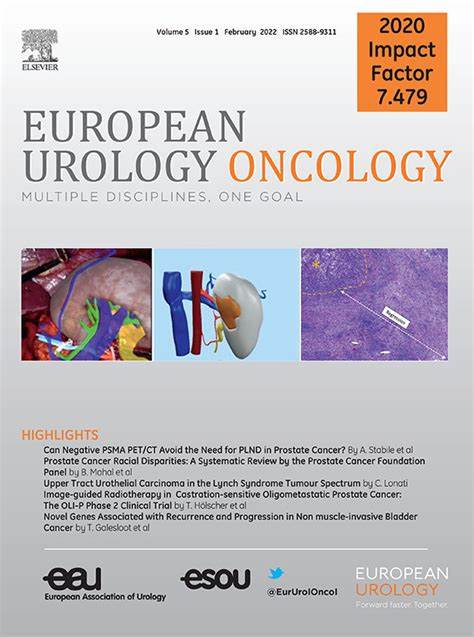活检格里森分级 1 组前列腺癌患者的死亡率风险。
IF 8.3
1区 医学
Q1 ONCOLOGY
引用次数: 0
摘要
背景和目的:我们研究了活检格里森分级(GGG)1级前列腺癌患者发病时的临床因素与未取样高危前列腺癌(PC)的存在、PC特异性死亡率(PCSM)以及根治性前列腺切除术后的全因死亡率(ACM)之间的关系:研究对象包括德国汉堡一家大学医院的队列研究中通过经直肠超声(TRUS)引导的系统活检(SBx;n = 9248)或联合活检(CBx;SBx + TRUS/磁共振成像 [MRI] 融合活检;n = 980)确诊的 10228 例 GGG1 PC 患者。我们采用逻辑回归、Fine and Grays回归和Cox多变量回归方法计算了不良病理结果的调整赔率(aOR)以及早期前列腺特异性抗原(PSA)失效(≤18个月)、PCSM和ACM的调整危险比(aHR)与各临床因素的关系:无论采用哪种活检方法,活检阳性率(PPB)>50%和PSA>20 ng/ml与较高的不良病理风险(SBx:aOR分别为1.71和3.49;CBx:aOR分别为1.81和2.82)和早期PSA失败(SBx:aHR分别为1.54和4.37;CBx:aHR分别为2.88和7.81)显著相关。在 SBx 组,PPB >50% 和 PSA >20 ng/ml 也与较高的 PCSM(aHRs 2.56 和 3.71)和 ACM(aHRs 1.47 和 2.00)风险相关(所有 p 均小于 0.04)。结论和临床意义:结论和临床意义:对GGG1和PPB>50%或PSA>20 ng/ml的患者维持 "癌症 "分类,并考虑重新检查以确定未取样的高级别疾病,可最大限度地降低该亚组患者的死亡风险:对于接受非靶向前列腺活检的患者,大约每12名活检结果为1级前列腺癌的患者中就有1名可能患有比活检结果更具侵袭性的癌症。PSA(前列腺特异性抗原)水平过高(>20 ng/ml)或超过50%的活检样本中存在1级组癌,都可能是高危患者。本文章由计算机程序翻译,如有差异,请以英文原文为准。
Mortality Risk for Patients with Biopsy Gleason Grade Group 1 Prostate Cancer
Background and objective
We investigated the association of clinical factors at presentation with the presence of unsampled high-risk prostate cancer (PC) and PC-specific mortality (PCSM) and all-cause mortality (ACM) following radical prostatectomy in patients with biopsy Gleason Grade Group (GGG) 1 PC.
Methods
The study population comprised 10 228 patients treated for GGG 1 PC diagnosed via transrectal ultrasound (TRUS)-guided systematic biopsy (SBx; n = 9248) or combined biopsy (CBx; SBx + TRUS/magnetic resonance image [MRI] fusion biopsy; n = 980) from a cohort study at a university hospital in Hamburg, Germany. We used logistic, Fine and Grays, and Cox multivariable regression methods to calculate the adjusted odds ratio (aOR) of adverse pathology and adjusted hazard ratios (aHRs) for early prostate-specific antigen (PSA) failure (≤18 mo), PCSM, and ACM in relation to each clinical factor.
Key findings and limitations
Irrespective of biopsy approach, percent positive biopsies (PPB) >50% and PSA >20 ng/ml were significantly associated with higher risk of adverse pathology (SBx: aOR 1.71 and 3.49; CBx: aOR 1.81 and 2.82, respectively) and early PSA failure (SBx: aHR 1.54 and 4.37; CBx: aHR 2.88 and 7.81, respectively). PPB >50% and PSA >20 ng/ml were also associated with higher risk of PCSM (aHRs 2.56 and 3.71) and ACM (aHRs 1.47 and 2.00) in the SBx group (all p ≤ 0.04). The study is limited by the single-institution cohort design.
Conclusion and clinical implication
Maintaining the “cancer” classification for patients with GGG 1 and either PPB >50% or PSA>20 ng/ml and considering rebiopsy to identify unsampled high-grade disease may minimize the risk of mortality for this subgroup.
Patient summary
For patients undergoing non-targeted prostate biopsy, approximately 1 in 12 with a biopsy result of grade group 1 prostate cancer may have more aggressive cancer than the result suggests. A very high PSA (prostate-specific antigen) level (>20 ng/ml) or the presence of grade group 1 cancer in more than 50% of the biopsy samples can identify patients at risk.
求助全文
通过发布文献求助,成功后即可免费获取论文全文。
去求助
来源期刊

European urology oncology
Multiple-
CiteScore
15.50
自引率
2.40%
发文量
128
审稿时长
20 days
期刊介绍:
Journal Name: European Urology Oncology
Affiliation: Official Journal of the European Association of Urology
Focus:
First official publication of the EAU fully devoted to the study of genitourinary malignancies
Aims to deliver high-quality research
Content:
Includes original articles, opinion piece editorials, and invited reviews
Covers clinical, basic, and translational research
Publication Frequency: Six times a year in electronic format
 求助内容:
求助内容: 应助结果提醒方式:
应助结果提醒方式:


